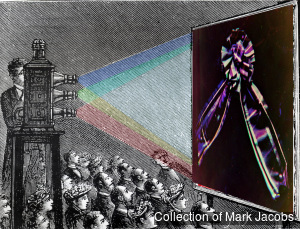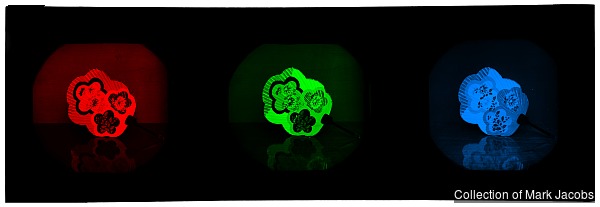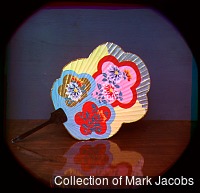
Early Color Photography
“When the World Turned to Color ” — 20th exhibition of Šechtl & Voseček Museum of Photography.

Illustration based on idea of Dr. Victor Minachin.
Most historians agree that color photography began with a lecture before the Royal Institution in London on May 17, 1861. Maxwell asked the photographer and inventor Thomas Sutton to take three separate black and white negatives through three colored liquid filters (red, green and blue) which resulted in three “separation negatives”. Sutton created positives from those negatives. These were then projected back through each of the same corresponding liquids. Maxwell’s purpose was not to present a method of color photography but did demonstrate the practicality of the additive color synthesis principle (RGB).
In the 1930’s the photo-chemist and inventor D. A Spencer learned that the actual positive plates used by Maxwell for his “three color” demonstration to the Royal Institution still existed at the Cavendish Laboratory at Cambridge. Spencer arranged to make three copy transparencies from them. Using those transparencies, Spencer made a color print by the Vivex color process, which as been used for nearly every subsequent reproduction of the famous tartan ribbon. Spencer’s copy negatives were re-discovered and scanned in 2010 by Mark Jacobs. In 2011 and 2012, Jan Hubicka provided the first digital reconstructions of the world’s fist color photograph.
The first commercial application of the threecolor process was made by the American, Frederic Eugene Ives who patented and marketed the “Photochromoscope,” (or Kromskop) in 1892. The three images were bound together into a single slide known as a Kromogram and could either be projected or placed in a stereo or standard Kromskop.
Ten years before they invented their Autochrome screen plate process, the Lumière’s were producing excellent color transparencies on glass by the subtractive color method using the necessary cyan, magenta, and yellow positive images and then superimposing the three dyed gelatines together. Called Trichromes by Lumière, another variation was marketed by Sanger Shepherd in the UK.
In 1914 John Capstaff at the Eastman Kodak Company devised the first film to bear the Kodachrome name. The system used two negatives, one exposed through a green filter and the other through a red filter. After development, a bleaching process removed the silver and hardened the gelatin in inverse proportion to the silver image. The film was then dyed in complementary colors—red-orange for the green exposure and blue-green for the red exposure and yielded color positives that could be attached to opposite sides of a piece of glass. The film produced remarkably good flesh tones though was used commercially by only one photographer, J E. Mock of Rochester, NY.
Because of the difficulty of using these processes, none of them had a future with amateur photographers, and soon lost out in competition with other color photographic processes that directly produced a color photograph on a single plate such as the Dufay, Paget, Finlay, but most especially, Lumière’s Autochrome process which consisted of tiny grains of starch dyed the same three primary colors of red, blue and green. Introduced in 1907, the Autochrome became the most successful product to produce color early images. It has been estimated that over twenty million autochromes were manufactured
Author: Mark Jacobs
